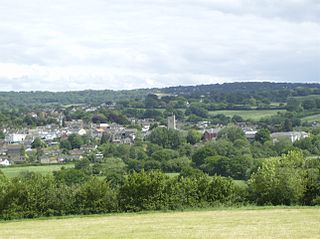
Axminster is a market town and civil parish on the eastern border of the county of Devon in England. It is 28 miles (45 km) from the county town of Exeter. The town is built on a hill overlooking the River Axe which heads towards the English Channel at Axmouth, and is in the East Devon local government district. At the 2001 census, it had a population of 5,626, increasing to 5,761 at the 2011 census. The town contains two electoral wards whose combined population is 7,110. The market is still held every Thursday.
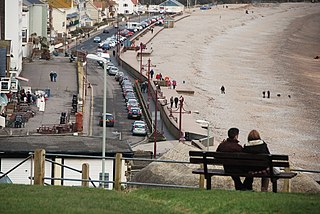
Seaton is a seaside town, fishing harbour and civil parish in East Devon on the south coast of England, between Axmouth and Beer. It faces onto Lyme Bay and is on the Dorset and East Devon Coast Jurassic Coast World Heritage Site. A sea wall provides access to the mostly shingle beach stretching for about a mile, and a small harbour, located mainly in the Axmouth area.
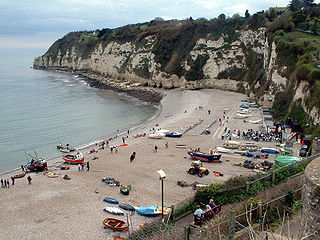
Beer is a seaside village and civil parish in the East Devon district of Devon, England. The village faces Lyme Bay and is a little over 1 mile (1.6 km) west of the town of Seaton. It is situated on the Jurassic Coast World Heritage Site and its picturesque cliffs, including Beer Head, form part of the South West Coast Path.

The West of England line is a British railway line from Basingstoke, Hampshire, to Exeter St Davids in Devon, England. Passenger services run between London Waterloo station and Exeter; the line intersects with the Wessex Main Line at Salisbury. Despite its historic title, it is not today's principal route from London to the West of England: Exeter and everywhere further west are reached more quickly from London Paddington via the Reading–Taunton line.

East Devon is a constituency represented in the House of Commons of the UK Parliament since 2019 by Simon Jupp of the Conservative Party.
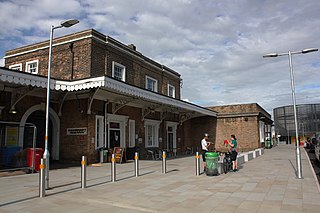
Taunton railway station is a junction station on the route from London to Penzance, 163 miles 12 chains (263 km) west of London Paddington station, measured via Box. It is situated in Taunton, Somerset, and is operated by Great Western Railway. The station is also served by CrossCountry trains and by the West Somerset Railway on special event days and by mainline steam excursions.

Honiton railway station serves the town of Honiton in east Devon, England. It is operated by South Western Railway and is 154 miles 60 chains (249.0 km) down the line from London Waterloo, on the West of England Line.

Axminster railway station serves the town of Axminster in Devon, England. It is operated by South Western Railway and is situated on the West of England Main Line. It is 144 miles 41 chains (232.6 km) down the line from London Waterloo.
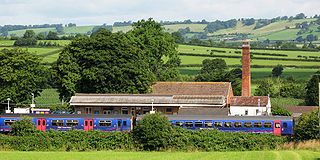
Castle Cary railway station is on the Reading to Taunton line 115.25 miles (185.48 km) south west of London Paddington and the Bristol to Weymouth line 47.75 miles (77 km) south of Bristol Temple Meads. The two routes share tracks between Westbury and Castle Cary stations and are both operated by Great Western Railway, which also manages the station. The station is 1 mile (1.6 km) north of the market town of Castle Cary and 5 miles (8 km) south of Shepton Mallet in a largely rural area of Somerset, England.

Liskeard railway station serves the town of Liskeard in Cornwall, England. The station is approximately 18 miles (29 km) west of Plymouth on the Cornish Main Line and 264 miles 71 chains (426.3 km) from London Paddington via Box and Plymouth Millbay. It is the junction for the Looe Valley Line. The railway station is situated approximately 0.5 miles (0.80 km) south-west of Liskeard town centre.

Honiton was a parliamentary constituency centred on the town of Honiton in east Devon, formerly represented in the House of Commons of the Parliament of the United Kingdom. It sent members intermittently from 1300, consistently from 1640. It elected two Members of Parliament (MPs) until it was abolished in 1868. It was recreated in 1885 as a single-member constituency.

Colyton is a town in Devon, England. It is located within the East Devon local authority area, the river River Coly runs through it. It is 3 miles (5 km) from Seaton and 6 miles (10 km) from Axminster. Its population in 1991 was 2,783, reducing to 2,105 at the 2011 Census. Colyton is a major part of the Coly Valley electoral ward. The ward population at the above census was 4,493.

Colyford is a village and civil parish in the East Devon district, in the county of Devon, England. It is situated midway between Lyme Regis and Sidmouth on the A3052 road. To the north the village borders the town Colyton. To the south is the seaside resort town Seaton, separated from Colyford by the Seaton Wetlands, a series of nature reserves flanking the estuary of the River Axe. Colyford lies on the River Coly, which flows into the River Axe immediately to the east of the village.

Wadebridge railway station was a railway station that served the town of Wadebridge in Cornwall, England. It was on the Bodmin and Wadebridge Railway.
This article describes the history and operation of the railway routes west of Salisbury built by the London and South Western Railway (LSWR) and allied companies, which ultimately became part of the Southern Railway in the United Kingdom. Salisbury forms a natural boundary between the Southern Railway core routes in the counties surrounding London, and the long route connecting with the Devon and Cornwall lines.

Halwill Junction Railway Station was a railway station in Halwill Junction, near the villages of Halwill and Beaworthy in Devon, England. It opened in 1879 and formed an important junction between the now-closed Bude Branch and North Cornwall line. It closed in 1966 along with the lines which it served, a casualty of the Beeching Report.

Chard Junction railway station was situated on the London and South Western Railway’s West of England Main Line about 1 mile (1.6 km) southeast of the village of Tatworth in Somerset, England. It was the junction of a short branch line to Chard. It was opened in 1860 as Chard Road, and closed in 1966. An adjacent milk depot was served by its own sidings from 1937 to 1980. Chard Junction signal box remained open to control Station Road level crossing and a passing loop on the long section of single track railway between Yeovil Junction and Pinhoe until March 2021, when control was passed to Basingstoke.
The Seaton branch line was a railway branch line connecting the seaside resort of Seaton, Devon, in England, to the main line network at Seaton Junction railway station, on the main line between Salisbury and Exeter.

Colyford railway station, and its successor the Colyford tram stop, serve the village of Colyford in Devon, England. It was open as a railway station, on the Seaton branch line, between 1868 and 1966, and has been open as a tram stop, on the Seaton Tramway, since 1971. It is located on the eastern side of the village of Colyford, adjacent to the White Hart Inn, where the line crosses the A3052 road on a level crossing.

Colyton railway station, and its successor the Colyton tram stop, serve the town of Colyton in Devon, England. It was open as a railway station, on the Seaton branch line, between 1868 and 1966, and has been open as a tram stop, on the Seaton Tramway, since 1980. The station is situated some 0.5 miles (0.80 km) to the east of Colyton town centre.




















